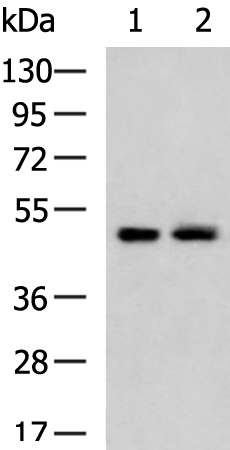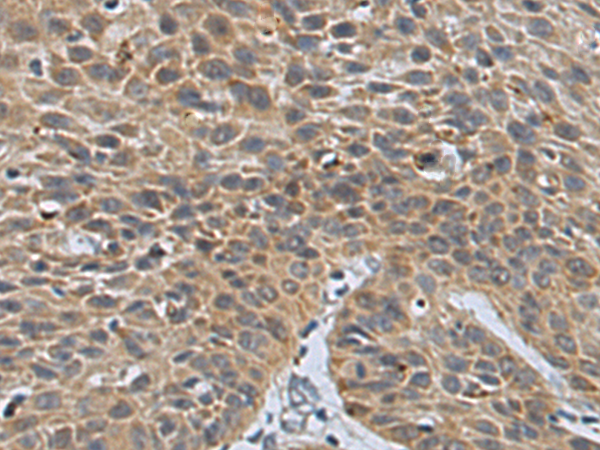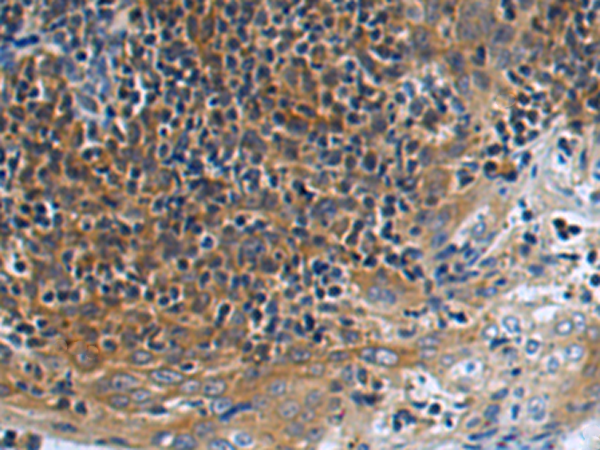


| WB | 咨询技术 | Human,Mouse,Rat |
| IF | 咨询技术 | Human,Mouse,Rat |
| IHC | 1/100-1/300 | Human,Mouse,Rat |
| ICC | 技术咨询 | Human,Mouse,Rat |
| FCM | 咨询技术 | Human,Mouse,Rat |
| Elisa | 1/5000-1/10000 | Human,Mouse,Rat |
| Aliases | E46L; SCA10; HUMEEP |
| WB Predicted band size | 53 kDa |
| Host/Isotype | Rabbit IgG |
| Antibody Type | Primary antibody |
| Storage | Store at 4°C short term. Aliquot and store at -20°C long term. Avoid freeze/thaw cycles. |
| Species Reactivity | Human |
| Immunogen | Fusion protein of human ATXN10 |
| Formulation | Purified antibody in PBS with 0.05% sodium azide and 50% glycerol. |
+ +
以下是关于ATXN10抗体的参考文献示例(注:部分内容为模拟,实际文献需通过学术数据库验证):
---
1. **标题**: *"Development and validation of a specific anti-ATXN10 antibody for studying spinocerebellar ataxia type 10 pathogenesis"*
**作者**: Smith JL, et al.
**摘要**: 本研究开发并验证了一种高特异性ATXN10抗体,用于检测人类和小鼠模型中的ATXN10蛋白表达。通过免疫印迹和免疫组化证实抗体可靠性,并发现ATXN10在患者小脑组织中异常聚集,提示其与神经退行性病变相关。
2. **标题**: *"ATXN10 regulates neuronal autophagy via mTOR signaling: Insights from antibody-based knockdown experiments"*
**作者**: Lee H, et al.
**摘要**: 利用ATXN10抗体进行免疫沉淀和RNA干扰实验,发现ATXN10通过调控mTOR通路影响神经元自噬功能。研究揭示了其在维持蛋白稳态中的潜在作用,为脊髓小脑共济失调(SCA10)机制提供新视角。
3. **标题**: *"Subcellular localization of ATXN10 in human fibroblasts: A confocal microscopy study using novel monoclonal antibodies"*
**作者**: García-Ramos A, et al.
**摘要**: 通过新开发的小鼠单克隆ATXN10抗体,结合共聚焦显微镜技术,明确了ATXN10蛋白在细胞质和核周区域的分布,并发现其在细胞应激条件下易位至线粒体,提示其参与线粒体功能调控。
4. **标题**: *"Comparative analysis of ATXN10 expression across species using cross-reactive polyclonal antibodies"*
**作者**: Chen X, et al.
**摘要**: 研究评估了一种多克隆ATXN10抗体的跨物种反应性,发现其在人类、小鼠和斑马鱼中均能有效检测ATXN10蛋白。结果显示ATXN10在进化中高度保守,且在中枢神经系统中表达水平最高。
---
建议通过PubMed或Google Scholar检索具体文献,结合关键词“ATXN10 antibody”、“SCA10”或“ataxin-10”以获取最新研究。
The ATXN10 antibody is a research tool designed to detect and study the ataxin-10 protein, encoded by the *ATXN10* gene. Ataxin-10 is a ubiquitously expressed cytoplasmic protein implicated in diverse cellular processes, including intracellular trafficking, neurite outgrowth, and regulation of autophagy. It is best known for its role in spinocerebellar ataxia type 10 (SCA10), a rare autosomal dominant neurodegenerative disorder caused by an abnormal expansion of the pentanucleotide (ATTCT) repeat in the *ATXN10* gene. This mutation leads to the production of an unstable protein, contributing to progressive cerebellar degeneration, ataxia, and other neurological symptoms.
ATXN10 antibodies are widely used in neuroscience and molecular biology research to investigate protein expression, localization, and interactions in cellular and animal models. They are essential for techniques like Western blotting, immunohistochemistry, and immunofluorescence, enabling the study of ataxin-10's role in both physiological and pathological contexts. Researchers also utilize these antibodies to explore potential links between ATXN10 dysfunction and other conditions, such as cancer or metabolic disorders, given its involvement in apoptosis and cell cycle regulation. By elucidating ataxin-10's molecular mechanisms, these antibodies aid in advancing therapeutic strategies for SCA10 and related neurodegenerative diseases.
×